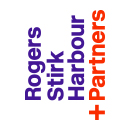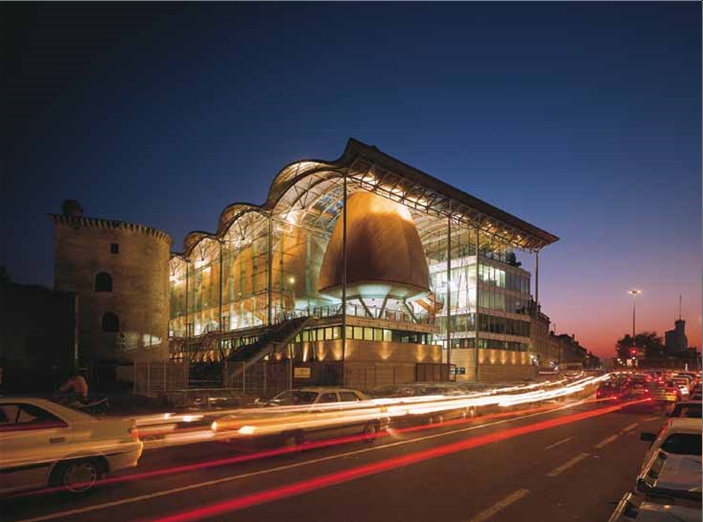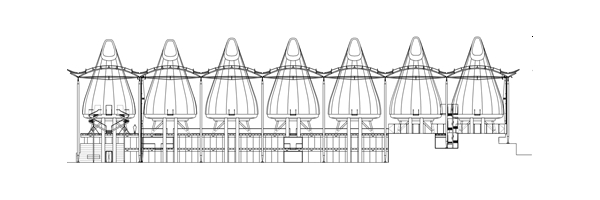Bordeaux Law Courts
The design concept involved ‘liberating’ the court-rooms from the ‘box’. The timber-clad solution employs a mix of high technology, computer-controlled machinery and traditional craftsmanship.
Richard Rogers Partnership (RRP, now Rogers Stirk Harbour + Partners, RSH+P) won the international competition to design new law courts for the historic city of Bordeaux in 1992. The design was for a building that would, through a feeling of transparency and openness, create a positive perception of the accessibility of the French judicial system. The brief was complex, requiring complete separation of public and judicial circulation. By pulling the building into its constituent parts, the resulting transparency encourages a sense of orientation, rendering an historically imposing institution more accessible.
Key elements of the design include the creation of public space and integration with the existing urban landscape. Public entry to the building is via a flight of stairs placed to the side, leading to the ‘Salle des Pas Perdus’ at the core of the building, where lawyers, their clients and the public meet.
The seven courtroom pods are clad in cedar, raised on pilotis above the limestone plinth within a great glass curtain wall under an undulating copper roof. The administrative offices are reached by bridges spanning the atrium – the clarity of the plan ensuring that different secure routes across the atrium are maintained both for the public and for magistrates. With its use of irregular forms and natural materials, the building successfully complements its sensitive environs, including a section of the city’s medieval wall. A strong emphasis is placed on effective passive control systems. The pods are shaded beneath the great roof and manually-operated brise-soleil windows along the western façade reduce solar gain. The flask-like volumes allow daylight deep into the court rooms and, through their height, ensure temperature control through stratification. The glazed box wrapping around the chambers, with its sun-screening and ventilation systems incorporated within the roof, functions as a breathing container. In addition, the podium and offices are built in concrete – a very effective passive heat control system.
Project information:
- Place / Date: Bordeaux, France 1992—1998
- Client: Tribunal de Grande Instance
- Cost: £27 million
- Gross Internal Area: 25,000m²
- Architect: Richard Rogers Partnership
- Structural Engineer: Ove Arup & Partners/OtH Sud-Ouest
- Services Engineer: OtH Sud-Ouest/Ove Arup & Partners
- Quantity Surveyor: Interfaces, Ingèrop
- Acoustic Consultant: Sound Research Laboratories
- Cladding Consultant: Rice Francis Ritchie
- Landscape Architect: Dan Kiley/Edward Hutchison/Branch Associates
- Lighting Consultant: Lighting Design Partnership
- Main Contractor: Spie Citra Midi Atlantique
- Site Management: OtH Sud-Ouest
Click here to see the full job sheet.
--RSHP
Featured articles and news
Government consultations for the summer of 2025
A year of Labour, past and present consultations on the environment, the built environment, training and tax.
CMA competitiveness probe of major housing developers
100 million affordable housing contributions committed with further consultation published.
Homes England supports Greencore Homes
42 new build affordable sustainable homes in Oxfordshire.
Zero carbon social housing: unlocking brownfield potential
Seven ZEDpod strategies for brownfield housing success.
CIOB report; a blueprint for SDGs and the built environment
Pairing the Sustainable Development Goals with projects.
Types, tests, standards and fires relating to external cladding
Brief descriptions with an extensive list of fires for review.
Latest Build UK Building Safety Regime explainer published
Key elements in one short, now updated document.
UKGBC launch the UK Climate Resilience Roadmap
First guidance of its kind on direct climate impacts for the built environment and how it can adapt.
CLC Health, Safety and Wellbeing Strategy 2025
Launched by the Minister for Industry to look at fatalities on site, improving mental health and other issues.
One of the most impressive Victorian architects. Book review.
Common Assessment Standard now with building safety
New CAS update now includes mandatory building safety questions.
RTPI leader to become new CIOB Chief Executive Officer
Dr Victoria Hills MRTPI, FICE to take over after Caroline Gumble’s departure.
Social and affordable housing, a long term plan for delivery
The “Delivering a Decade of Renewal for Social and Affordable Housing” strategy sets out future path.
A change to adoptive architecture
Effects of global weather warming on architectural detailing, material choice and human interaction.
The proposed publicly owned and backed subsidiary of Homes England, to facilitate new homes.
How big is the problem and what can we do to mitigate the effects?
Overheating guidance and tools for building designers
A number of cool guides to help with the heat.
The UK's Modern Industrial Strategy: A 10 year plan
Previous consultation criticism, current key elements and general support with some persisting reservations.
Building Safety Regulator reforms
New roles, new staff and a new fast track service pave the way for a single construction regulator.




























